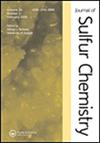双(4-氟苯基甲基磺酰二酮):合成、结构和杀真菌性能
IF 1.6
3区 化学
Q3 CHEMISTRY, MULTIDISCIPLINARY
引用次数: 0
摘要
在有机催化剂的存在下,以2,4-戊二酮、α,ω-烷二醇和4-氟苯甲醛为原料,通过多组分硫甲基化反应合成了一系列双(4-氟苯基甲基磺酰二酮)。发现发育的α-单取代β-二酮主要以酮的形式存在。考虑到绿色化学指标,对目标分子合成的工业实施前景进行了评价。在所制备的双磺酰二酮类化合物中,在双(4-氟苯基甲基磺酰二酮)分子的硫原子之间含有4,4′-硫代二苯间隔剂的化合物对植物病原真菌sorokinibipolaris、oxysporum镰刀菌和solani Rhizoctonia的杀真菌活性最高。本文章由计算机程序翻译,如有差异,请以英文原文为准。
Bis(4-fluorophenylmethylsulfanyldiketones): synthesis, structure and fungicidal properties
A series of bis(4-fluorophenylmethylsulfanyldiketones) were synthesized by multicomponent thiomethylation reaction between 2,4-pentanedione, α,ω-alkanedithiols, and 4-fluorobenzaldehyde in the presence of an organocatalyst. It was found that the developed α-monosubstituted β-diketones mainly exist in the keto form. Considering the green chemistry metrics, the prospects for industrial implementation of the synthesis of target molecules were evaluated. Among the prepared bis-sulfanyl diketones, the highest fungicidal activity against the plant pathogenic fungi Bipolaris sorokiniana, Fusarium oxysporum, and Rhizoctonia solani was found for the compound containing a 4,4′-thiodibenzene spacer between the sulfur atoms in the bis(4-fluorophenylmethylsulfanyldiketone) molecule.
求助全文
通过发布文献求助,成功后即可免费获取论文全文。
去求助
来源期刊

Journal of Sulfur Chemistry
CHEMISTRY, MULTIDISCIPLINARY-
CiteScore
4.10
自引率
9.10%
发文量
38
审稿时长
6-12 weeks
期刊介绍:
The Journal of Sulfur Chemistry is an international journal for the dissemination of scientific results in the rapidly expanding realm of sulfur chemistry. The journal publishes high quality reviews, full papers and communications in the following areas: organic and inorganic chemistry, industrial chemistry, materials and polymer chemistry, biological chemistry and interdisciplinary studies directly related to sulfur science.
Papers outlining theoretical, physical, mechanistic or synthetic studies pertaining to sulfur chemistry are welcome. Hence the target audience is made up of academic and industrial chemists with peripheral or focused interests in sulfur chemistry. Manuscripts that truly define the aims of the journal include, but are not limited to, those that offer: a) innovative use of sulfur reagents; b) new synthetic approaches to sulfur-containing biomolecules, materials or organic and organometallic compounds; c) theoretical and physical studies that facilitate the understanding of sulfur structure, bonding or reactivity; d) catalytic, selective, synthetically useful or noteworthy transformations of sulfur containing molecules; e) industrial applications of sulfur chemistry; f) unique sulfur atom or molecule involvement in interfacial phenomena; g) descriptions of solid phase or combinatorial methods involving sulfur containing substrates. Submissions pertaining to related atoms such as selenium and tellurium are also welcome. Articles offering routine heterocycle formation through established reactions of sulfur containing substrates are outside the scope of the journal.
 求助内容:
求助内容: 应助结果提醒方式:
应助结果提醒方式:


